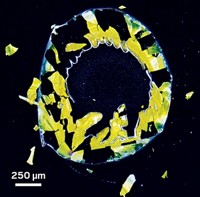Advertisement
Grab your lab coat. Let's get started
Welcome!
Welcome!
Create an account below to get 6 C&EN articles per month, receive newsletters and more - all free.
It seems this is your first time logging in online. Please enter the following information to continue.
As an ACS member you automatically get access to this site. All we need is few more details to create your reading experience.
Not you? Sign in with a different account.
Not you? Sign in with a different account.
ERROR 1
ERROR 1
ERROR 2
ERROR 2
ERROR 2
ERROR 2
ERROR 2
Password and Confirm password must match.
If you have an ACS member number, please enter it here so we can link this account to your membership. (optional)
ERROR 2
ACS values your privacy. By submitting your information, you are gaining access to C&EN and subscribing to our weekly newsletter. We use the information you provide to make your reading experience better, and we will never sell your data to third party members.

Inorganic nanocrystals can self-assemble into different conformations, such as tubes and hexagonal networks. Capillary or van der Waals forces often drive this self-organization. The colorized transmission electron microscope image here shows self-assembled iron oxide nanocrystals. In the green areas, the particles form a honeycomblike structure, whereas in the blue areas, they align in rows. To produce these snakeskin-like patterns, researchers synthesized a solution of the nanocrystals and evaporated a drop of it on a grid. The lab from the National University of La Plata that made this image investigates how iron oxide nanoparticles increase the responsiveness of heat-sensitive surfaces.
Submitted by Loro Corazza/SupramoleculART
Do science. Take pictures. Win money. Enter our photo contest here.
Related C&EN content:
For more Chemistry in Pictures, visit our new home on cen.acs.org.





Join the conversation
Contact the reporter
Submit a Letter to the Editor for publication
Engage with us on Twitter